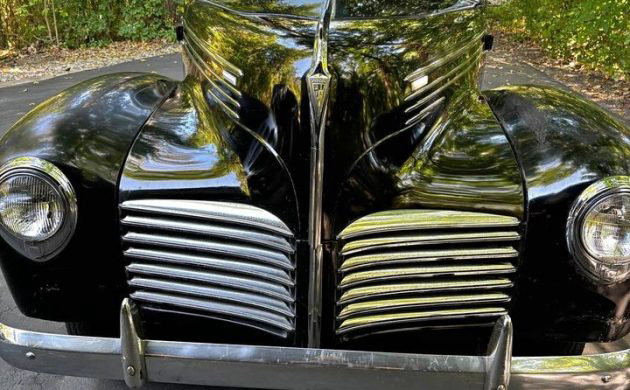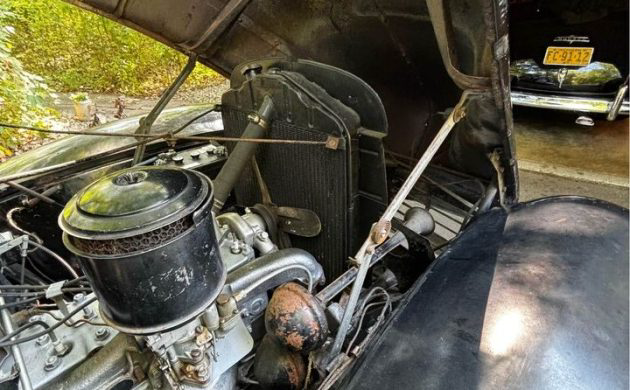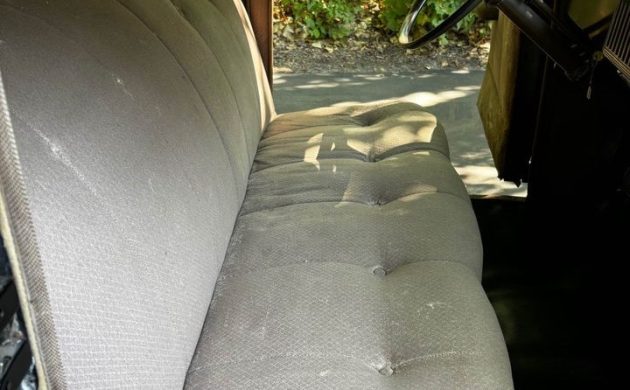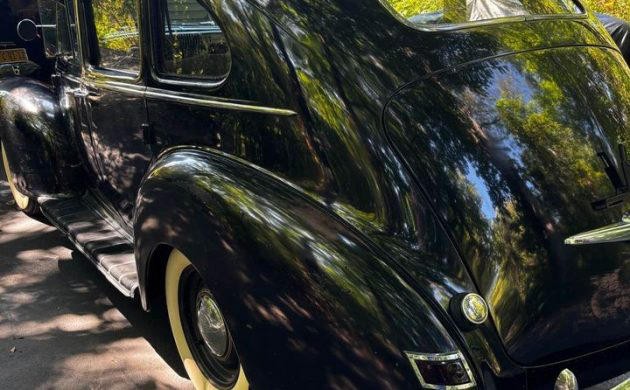Hudson’s nameplate disappeared by 1957, so we tend to forget that the company invented numerous mechanical advancements now taken for granted, including the balanced crankshaft, dash warning lights, and dual brakes – a mechanical backup when hydraulic pedal travel exceeded normal range. Attentive to safety even in the 1930s, the company changed the geometry of its suspension components, introducing “rhythmic ride” to ameliorate bump steer. This 1940 Hudson Traveler four-door sedan benefited from a sheet metal facelift conducted across the company’s entire lineup that year. With sealed beam headlamps, a twin grille arrangement, and a move toward making running boards optional, the styling signaled a modern shift. We’re lucky that T.J. sent us this tip, so we could boast about this orphan make.
The Traveler was the “little” Hudson Six, on a 113″ wheelbase. From the factory, it received a 92 hp, 175 cu. in. flathead six-cylinder engine, accompanied by a three-speed non-synchro manual transmission. But this car, which the seller purchased from a museum, was upgraded to an all-synchro transmission from a ’41. A long list of mechanical work was performed at the same time, including new valves, head gasket, fuel pump, muffler, and brakes. The carburetor and starter were rebuilt and the entire fuel system was cleaned up. The radiator was refurbished, and the car has new U-joints and shocks. A new wiring harness and generator will keep those electrons moving.
The interior is said to be original and unrestored – it’s in remarkably fine condition, showing just the slightest patina. Instruments are bisected by emphatic polished climate vents; I love the soft shape of the gauge pods – a remnant of Art Deco influence. In addition to safety, Hudson touted its good fuel economy and comfort – an early example of trying to be all things to all people. The car’s documents include an early registration and title in the name of Mrs Amy Shepard, photos of the car in period … even a letter from Hudson Motors congratulating the new owner.
The seller notes that the paint is original, and while the photos don’t do the car justice, the cosmetics do appear decent if slightly worn. No doubt its decades in a museum helped keep the rust devil at bay. This car is for sale on facebook Marketplace, with an asking price of $14,500 or best offer, and it’s located in Grand Rapids, Michigan. We also found the same car on consignment here at GR Auto Gallery, for $13,400. Interestingly, the GR Auto detail indicates that the engine is a 212 cu. in. six, which was fitted to the Super Six, not the Traveler. This Hudson’s originality and known history are attractive attributes – but judging by the $13,000 sale of this beautiful touring sedan with the more competent eight-cylinder engine, this Traveler might need a price check.









Never seen one of these before, nice to see something a little different than the usual fare for this era of sedans.
Such a shame, you young whippersnappers wouldn’t know a great car if it ran them over,,m’kay, too harsh, but a bit of merit. I think with such few comments, perhaps the author went over our heads with the use of words like “ameliorate” ( from Homer Simpson when he was briefly smart), meaning to correct or resolve, and bump steer, from my old pickup posts, when cars had a straight front axle and king pins, the shock of one wheel hitting a pothole, or obstacle, sends it to the other front wheel, and if not prepared, well, let’s just say, next time, you’ll know. Independent suspension solved that. HD trucks still use it today.
It’s a fantastic find for us geezers a fixin’ to die( rag), but posted for a week, they’re not exactly jumping over another to get it. All these have red flags a Snowflake has no experience with, and like it or not, it’s who is next up at bat. “Why won’t my phone charge,,,6 VOLTS,,,what the heck is that?” It’s not easy trying to explain what the attraction was with a Hudson, to them, it’s just an old, polluting relic, that has no use in a modern society.
It should be noted, in 1940, the Hudson 4 door was the least expensive car in America, at $670 BUCKS! ( I had to look that up twice) when a Ford was almost $150 more. Doesn’t sound like much, and in 1940, we were blissfully unaware of what was to come next, but remember, before the war, workers made about $28/week, almost $40 once the war began, but you couldn’t buy anything, so a new car, even at that cost, was out of most folks budgets.
I know, I spell gloom and doom often, and for good reason, but I do believe there’s enough of “us” left, that will come forward, but see, therein lies the rub. The folks that might still enjoy a car like this don’t have a pit to hiss in, and would have a tough time justifying 5 figures on something they may never use. Yeah, the ravages of age,,,these were wonderful cars.
I’m with ya 100% Howard…and have been noticing it for years- the market for these beauties has dropped like a rock- we, the old timers have to step up to the plate and keep them on the road…but I think it’s a losing battle..:<(
It can be a winnng proposition. I am meeting more young gear heads at Cars and Coffee who want to restore these old beauties. The biggest obstacle for them is, alas, the same one us old coots face, money!
Yep, we are definitely a dying breed, but at my age, 85, then I suppose it’s to be expected! I hope that when I croak, if I go somewhere else after taking my last breath, as some people say they have been there but I have my doubts, that there are old, collectible cars and bikes to be had otherwise I’m not going!
Agreed, Howard–but I’m an old coot.
At sixty-four I should be old enough to have appreciated these cars much earlier. My influence was the sixties cars my brother and his friends drove and the seventies cars I grew up with. One might recall the “fat-fender” movement in eighties and later that brought attention to the pre/post War cars. Early Fords and tri-five Chevies were ubiquitous. These were different and still plentiful. Buying and driving this Hudson would be an interesting and fulfilling appreciation for cars of this era, whether you are young or just coming around like me.
I think the 175 cid was only for across the ocean countries. The 212 was the most common engine.
Very Nice…..and Very Rare!
I’m wondering where the minute hand on the dashboard clock goes at the bottom of the hour.
Good catch Jerry. There must be a gap at the bottom for the hour hand and second hand to pass through, for the clock to be able to work.
These look like a 40 Ford with a big butt – google it to see the side view of the car. Cool car – lots of fixed up already done, just drive and enjoy.
I don’t recall seeing a ’40 Hudson sedan on the road back in the day but, I well remember an elderly gent who regularly drove a maroon ’40 Hudson Club Coupe about town. He would take his two Irish Setters to the county park for a bit of a run. Both dogs would strike a regal pose sitting erect in the back seat to and from the park. The old gent’s car was some fifteen or sixteen years old at the time but, looked like it had just rolled out of the showroom. I’ve liked the looks of 1940 Hudsons ever since, especially the aggressive looking ’40 Hudson Pickup.
Fine point— the car model is a 40-P, Delux6. It’s a common mistake. A true “ Traveler “ doesn’t have the vent windows and no chrome trim around the windshield. That’s the easiest way to tell the models apart. The cost difference between the two was minimal. Both serial numbers began with the same “40” – they were the least expensive ones and Hudson didn’t separate them. The next series was designated by 41,42,43 and so on. The higher the second number, the fancier the model until you get to the truck and commercial series.
I have a 1940 Hudson model 40-P, the same as the one listed above.
This info is buried deep inside the Mechanical Procedure Manual in the front of the book.
Sorry, I don’t know how to add a picture of it.
Thanks, I was wondering about that. I had my doubts after doing the research but the seller called it a Traveler. The fact that it is a Deluxe explains why the engine is listed as a 212 instead of a 175, right?
No ,both the traveler and the Delux6 had the 175 92 hp engine.
The model differences are noted in the sales literature from the period.
There was a model 40 T,C, and P
for traveler, commercial and finally the p for ( some unknown reason) the Delux6.
Wow, thanks. I found the T and the P, I never even found the C….
@ SoloSoloUK
I’m with you there! No old Caddies to restore and play with, I’m not going either.
surprised no 1 covered the traveler point – the back (altho ‘sedan’ looking) opens up like a station wagon. I think there was another (Nash?) that did the same.
A ‘sleeper’ in more ways than One (is that where the nomenclature developed in the 1st place?).
That is the problem with growing older. What we value we find that our own kids and grandkids probably don’t. We have become a relic like the antiques we value. If I can instill in my kids good character to always do what’s right. Then I know that maybe I’ve left something behind that money can not buy. I enjoy the older cars regardless.
You are right Howard. I just hate to see these beauties selling for not enough to justify any repairs let alone restoration. If you want to own one buy the nicest one you can find and pay up for it.
As someone who’s actually owned a 40’s era Hudson (a 1948 Commodore 8, which, even though 8 years newer than the subject car, looked about the same), I can attest to a few things about these cars. 1) they are very simple mechanically…I’m a clod and I could work on mine. Though the cars are big, I could sit in mine, put it in neutral, and with one kick of my foot on the ground roll the car forward or backward….only car I’ve ever been able to do that with. 2) parts are impossible to find. Impossible. Nobody is making them, and when you do find parts, they are very, very expensive. 3) When you are ready to sell, be prepared to wait a long, long time to find a buyer. While people generally like these Hudsons, very few people want to own one. 4) The average age of the H-E-T club (Hudson-Essex-Terraplane for those of you uninitiated) seems to be about 80 years old. I’m not kidding. I was in my late 30’s when I had my Commodore 8 and I was, by far, the youngest person in the group. Not saying this is a good or bad thing, just making a point.
I really liked my Hudson, but the lack of being able to find parts, the lack of any real interest in it outside of myself, and it being one of the first cars I worked on restoring, I gave up and eventually sold it at a substantial loss to someone who was going to “rat rod” it. I never saw it again but my guess is that it’s probably in the condition it was in when I bought it: partially disassembled in someone’s garage.